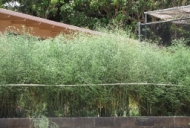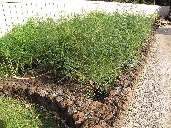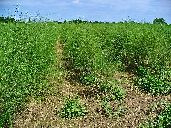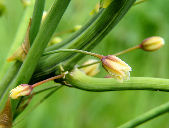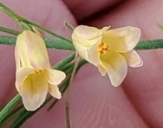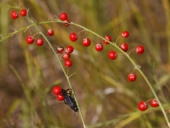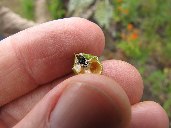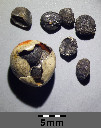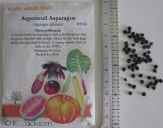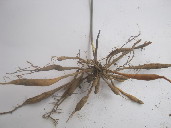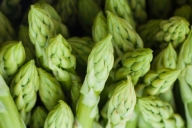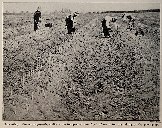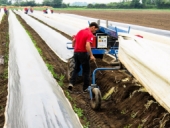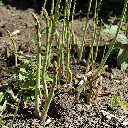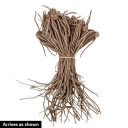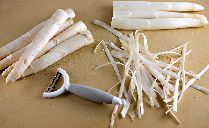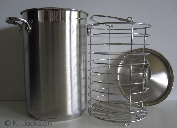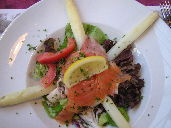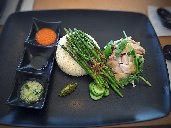| Asparagus - Asparagus officinalis | |||||||||||||||||||||||||||||||||||||||||||||||||||||||||||||||||||||||||
|---|---|---|---|---|---|---|---|---|---|---|---|---|---|---|---|---|---|---|---|---|---|---|---|---|---|---|---|---|---|---|---|---|---|---|---|---|---|---|---|---|---|---|---|---|---|---|---|---|---|---|---|---|---|---|---|---|---|---|---|---|---|---|---|---|---|---|---|---|---|---|---|---|---|
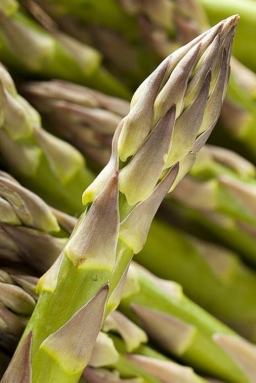 Fig. 1 Asparagus officinalis 'UC 157' F1  Fig. 2  Asparagus time 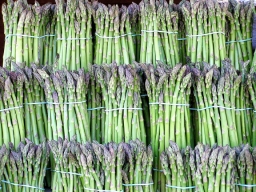 Fig. 3   Fig. 4  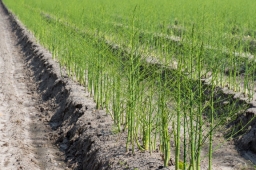 Fig. 5  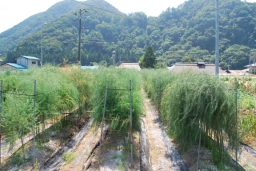 Fig. 6  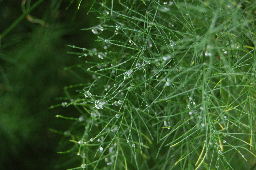 Fig. 10  A. officinalis with dewdrops 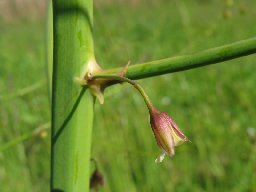 Fig. 15  Flower 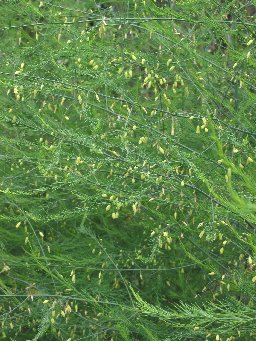 Fig. 16  Flowers 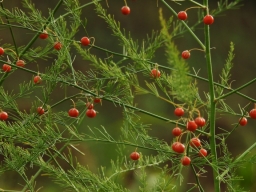 Fig. 22  Seeds  Fig. 27  A. officinalis planted along driveway border, Hawai'i  Fig. 29  Keep a look out for our good bugs Coccinella septempunctata 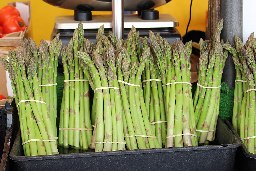 Fig. 33  Garden asparagus or sparrow grass (A. officinalis) in a market in Cambridge, England 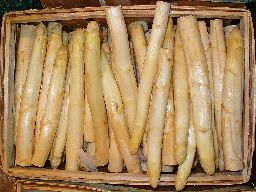 Fig. 34  A. officinalis Karlsruhe, Germany  Fig. 41  Asparagus tongs Metropolitan Museum of Art, New York 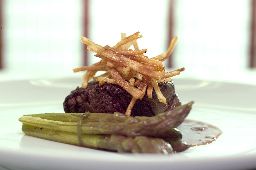 Fig. 42  Asparagus and meat 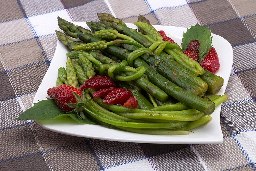 Fig. 43  Asperges rôties avec des fraises et liées avec des asperges des bois 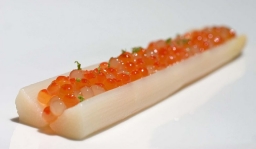 Fig. 44  White Asparagus, Smoked Salmon Roe, Maple Tapioca 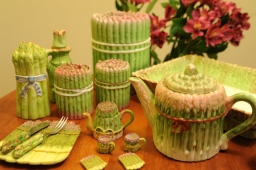 Fig. 45  Asparagus ceramic dish and tea pot collection | Scientific
name Asparagus officinalis L. Common names English: asparagus, garden asparagus, sparagrass, sparrowgrass; French: asperge; German: Spargel; Italian: asparagio; Japanese Romaji: oranda-kiji-kakushi; Portuguese: espargo; Spanish: espárrago, esparraguera; Swedish: sparris; Transcribed Chinese: shi diao bai 1,3 Synonyms A. caspius Hohen., A. longifolius Fisch. ex Steud., A. officinalis subsp. officinalis L., A. officinalis var. caspius (Hohen.) Asch. & Graebn., A. polyphyllus Steven ex Ledeb. 3 Family Liliaceae/Asparagaceae Origin Asparagus is native to the Mediterranean, eaten by the ancient Greeks 4 Uses Food, medicine Heights Erect 3-8 ft (1-2.5 m) 9 (Fig. 7) Plant habit Perennial Life span About 4-5 years before plants regress, when grown in North and Central Florida 1 Pruning requirement Late winter to remove dead foliage Foliage Light green; fern-like; sort to the touch Flowers Dioecious; bell-shaped with six tepals; male: yellow, 0.2-0.24 in. (5-6 mm) long; female: yellow-green, 0.16 in. (4 mm) long 10 Pedicels: up to 0.98 in. (25 mm) long 10 Fruit Red berry 0.24-0.39 in. (6-10 mm); young: green, mature: red, ripe: black 1,9 Seeds 2-4 black, with a wrinkled, brittle seed coat 9,10 Dormancy requirement for good spear production Usually cold weather or drought 1 Harvest season Spring Soil Well drained, sandy, light textured 5,7 pH preference 6.5-7.5 Seed spacing 4 in. (10 cm) apart in 6 in. (15 cm) deep furrows spaced 5 ft (1.5 m) apart 1 Crown spacing 12 in. (30 cm) apart; 6-8 in. (14-20 cm) deep; row: 5 ft (1.5 m) 1 USDA Nutrient Content pdf Light requirement Full sun Water requirement Supplemental irrigation during fern growth if there is insifficent rainfall Flood tolerance Not tolerant of saturated soil conditions 2 Salt tolerance Established asparagus generally tolerates salty soils better than most other vegetables 1,8 Cold tolerance Requires winter dormancy Temperature requirement 50-100 °F (10-38 °C) Temperature (optimum for harvesting) Daytime: 75-85 °F (24-29 °C); night: 55-66 °F (13-19 °C) 7 Roots Depth: 5-10 ft (1.5-3 m); width: 10-12 ft (3-3.5 m) 7 Invasive potential * Not a problem species Known hazard Asparagus sap or juice has been known to cause dermatitis 1,2 Reading Material Asparagus, UF/IFAS Gardening Solutions Asparagus - Asparagus officinalis L., University of Florida pdf Asparagus Production in New Mexico, New Mexico State University pdf Asparagus, Texas A&M AgriLife Extension pdf Origin Asparagus is depicted on Egyptian tombs dating from the 4th century BC and evidence suggests it was cultivated in ancient Rome. 10 Distribution Native: Northern Africa; Asia Temperate: Western Asia, Caucasus, Siberia, Middle Asia, Mongolia, China; Europe: Northern, Middle, Eastern, Southeastern, Southwestern. Cultivated (widely): Australisia: Australia, New Zealand; Europe: Northern, Eastern; Northern America: Canada, United States; Southern America: Western South America, Southern South America 3 Description Asparagus is not well adapted to Florida. It produces poorly in areas with mild winters and extremely long, hot summers. 1,5 The edible asparagus stalks are actually shoots that develop into fernlike leaves duringsummer. The plant continues to develop new shoots until the warm weather, when ferny growth develops from unharvested shoots. 6 It is an important commercial and garden crop throughout many parts of the United States. Four states, California, New Jersey, Washington, and Massachusetts, grow over 90% of the asparagus shipped to fresh markets in the United States. 1 Asparagus favors temperate climates. Optimal root and fern (foliage) growth occurs from 65-85 °F (18-29 °C). Spear (edible shoot) initiation occurs at soil temperatures above 50 °F (10 °C); spear elongation is faster at higher air temperatures. Root and fern development are reduced at temperatures below 55 °F (13 °C) or above 85 °F (29 °C). High temperatures cause the spear tips to open (“feather”) prematurely, reducing overall spear quality. 14 Under the best conditions (not in Florida) the beds can remain productive for 30 years or more. 1 For most home gardeners, a 20-foot row or 100 square feet of bed is adequate for a family of four. 5
Fig. 7. Habit, Hawai'i Fig. 8. Raised bed, Hawai'i Fig. 9. Habitus, Germany Foliage In all species of the genus Asparagus, what appear to be the leaves are in fact modified stems (cladodes or phylloclades); the true leaves are the scale-like structures on the stem (Fig. 12). 10 The reduced leaves and leaf-like cladodes are adaptive features enabling asparagus plants to survive and grow in regions with seasonally dry climates. The fern is a photosynthetically active modified stem. 7,10
Flowers
Pollination Open-pollinated varieties (non-hybrid varieties allowed to cross-pollinate freely) produce almost equal numbers of male and female plants. The plant’s sex has a pronounced effect on the quality and quantity of spears and on crop management practices. 7 Fruit/seed The female plants have the little red seed-bearing fruits. In central Florida, berries show up in July. This seed can become a serious weed problem for the established stand if allowed to germinate and establish. 1,7
Roots (crown) Young plants have compact buds in the center (crown), with numerous dangling, pencil-sized roots. Fibrous feeder roots develop from storage roots to accumulate nutrients and absorb moisture. 4,7
Cultivars UC 157 (Fig. 1) is widely grown in places like California and Mexico. It comes from the University of California breeding program. 1,2
Fig. 30. Dark green sprouts when grown in sunlight; varieties include 'Mary Washington', 'Martha Washington', 'Reading Giant', and 'Palmetto'. Fig. 31. Purple varieties include 'Purple Passion', and 'Pacific Purple' Fig. 32. Light green or whitish spears; white asparagus spears are grown in the absence of sunlight so that chlorophyll does not develop; varieties include 'Conover's Colossal', and 'Mammoth White'. 1,2 Harvesting Spear initiation and root growth begin when the soil temperature is above 50 °F. Optimum productivity occurs at 75-85 °F in the day and 55-66 °F at night. High daytime temperatures during harvest will loosen the spear tip and develop fiber in the stem, both of which reduce crop quality. 7 To cut a spear, run a knife into the soil at the base of the spear and carefully sever it. In California and certain other States, commercial asparagus growers still cut below the soil with a knife because the fibrous butt end of the spear helps to slow water loss in the tip of the spear so it can survive several days of transit. 4,11 To snap a spear, grasp it near the base and bend it toward the ground. The spear breaks at the lowest point where it is free of fiber. 4 Fiber development (toughness) of the spear is related to the tightness of the spear tip. The tighter the tip, the more tender the spear is. Spear diameter has no bearing on toughness. Do not harvest transplants the first year after planting, but both crown and transplant asparagus can be lightly harvested the second season. 7,11 Asparagus spear production depends on carbohydrates stored in the crown from the previous season, as sufficient stored carbohydrates are necessary after harvest to produce vigorous ferns. To have healthy, productive plants the following year, avoid excessive harvesting. When average spear groundline diameter declines to ¼ in. [remember, asparagus in Florida generally has weak and spindly spears], harvest should be stopped and plants allowed to produce ferns to replenish carbohydrates for the next season. 7 Spears allowed to fern out during harvest time must be removed and destroyed to deny insects a site to lay eggs and to prevent the delay of new emerging spears. 11
Fig. 35. Harvesting white asparagus - the stalks in the foreground were freed of earth for the taking of the photograph. 1923 Fig. 36. Women in war. Summer canning workers. Food to make America strong. Women near Rochelle, Illinois, many of them schoolteachers and pupils, work in asparagus canning factories during the summer months. 1942 Fig. 37,38,39. Asparagus fields Storage Asparagus is highly perishable and should be cooled as soon as possible to maintain quality. Asparagus can be hydrocooled with ice water and put into cold storage. Optimum storage temperature is 32-36 °F (0-2 °C) at 95% relative humidity, making storage of two to three weeks possible. Storage below optimum temperatures can lead to limp, mushy, discolored spears. Storage above optimum temperatures will result in partially open bracts and potential disease and rot problems. Phytophthora, Botrytis, and Fusarium rots can all occur when asparagus is stored at temperatures above the optimum range. 7 Propagation (by seed) Sow seeds ¾ to 1 inch deep and about 4 inches apart in 6-inch-deep furrows spaced 5 feet apart. Fill the furrow as you cultivate, until a level bed is obtained. 1 Crowns can also be grown from seeds planted in flats or peat cups. It takes at least a year to grow a good crown. 5 Seed storage 3-4 years Sowing season Spring Weeks to germination 2-6 1
Fig. 46. Seedling Site preparation Any preparation for planting asparagus should begin no later than the year before you plan to plant. 2 Although asparagus prefers sandy soil, anything you can do to raise the organic matter of the soil before planting will also pay big benefits. Many Florida gardeners dig pits and fill with an abundant amount of organic compost on which to grow the asparagus. If water stands in the spot you have chosen for only an hour, it is probably too wet for asparagus. 1,2 Transplanting During the spring plant 1 or 2 year old crowns in a 6-8 in. (14-20 cm) deep trench 12 in. (30cm) apart. Cover with 3 in. (8 cm) soil. Let the new plants grow through that soil for about 6 weeks and add another 3 inches of soil. Wait until the plants have gone dormant in the late fall or in the spring before growth begins to finish filling the trench. The traditional way to grow it is to plant crowns on the soil surface instead of trenches and to mound dirt up over the rows. 1,2
A. officinalis 'Mary Washington Improved' crown as arrives by mail order Pruning / Dormant Season Management Remove ferns in early winter when they are completely dormant and brown. Removing ferns makes harvesting easier in spring and reduces overwintering sites for insects and diseases. Ferns can either be burned, mowed, or baled. Before spear emergence, lightly rototill the beds to remove any remaining fern material. Be careful not to damage crowns under the soil surface. A layer of soil 2 to 3 in. deep should then be added to the tops of the beds with a border disk. The rototilling and extra soil make harvesting easier, creating a clean bed. The additional soil also tends to increase spear diameter. 7 Fertilizing Larger buds generally result in larger spears, while smaller buds yield small spears. Bud size is most influenced by the plant’s overall vigor the previous year. 7 Growing conditions that favor healthy fern development and the accumulation of carbohydrates (food reserves) in the crown and root system thus enhance size and vigor of buds and subsequent spears. 7 Asparagus should be fertilized in the same way as the rest of the garden the first 3 years. In the spring, apply 10-10-10, 12-12-12 or 15-15-15 fertilizer at the rate of 20 to 25 pounds per 1,000 square feet of area or 2 pounds per 100 square feet and incorporate with soil tillage. Starting in the fourth year, apply the same amount of fertilizer but delay application until June or July (immediately after the final harvest). This approach encourages vigorous growth of the "fern," which produces and stores nutrients in the roots for next year's production season. 4 Irrigation If there is insufficient rainfall asparagus should be irrigated mostly during the fern season, but not the harvest season. However, supplemental irrigation during the harvest season may be necessary on sandy soils in dry areas. During the first year, irrigation should closely follow planting. Asparagus should be well-irrigated throughout the first year. Unfortunately overhead irrigation makes an ideal environment for foliar diseases. 2,6 Culture Good asparagus spear production is dependent upon a dormant period. Dormancy is usually brought about by cold weather or drought, and since Florida has neither, growth is more or less continuous, resulting in weak, spindly spears. 1 Pests Melon Aphid or Cotton Aphid, Aphis gossypii Glover, University of Florida pdf Japanese Beetle, Popillia japonica Newman, University of Florida pdf Weeds Keep down weeds in the asparagus plantings. If you weed with a hoe, avoid wounding the root or the soon-to-emerge spears. 6 Food uses Fresh, canning 4
Fig. 48. Steam-boiling green asparagus (A. officinalis) in a stainless steel pot in Lysekil, Sweden. By not submerging the whole asparagus, the tender tops of the shoots will only be steamed and retain their crispiness Fig. 49. Peeling white asparagus Fig. 50. Specially designed for steaming asparagus Fig. 51. Dish with asparagus in Belgium Fig. 52. Roasted Asparagus Fig. 53. Hainanese Chicken Rice with asparagus Fig. 54. Asparagus in jars Medicinal Properties ** Eating asparagus can give a characteristic odour to the urine, due to the breakdown of compounds containing sulphur. However, not all people produce this smell, and people also vary in their ability to detect it. 10 Activities - Antiaging; Antibacterial; Anticancer; Antiinflammatory; Antileukemic; Antioxidant; Antirheumatic; Antiviral; Bitter; Cardiosedative; Cardiotonic; Contraceptive; Demulcent; Depurative; Detoxicant; Diuretic; DNA-Sparing; Hepatoprotective; Hypotensive; Immunostimulant; Laxative; Litholytic; Nematicide; Sedative; Spermicide. Indications - Acne; Anemia; Anorexia; Arthrosis; Asthma; Bacteria; Bladder Stone; Cancer; Cancer, mouth; Cancer, pharynx; Cardiopathy; Cholecystosis; Constipation; Cough; Cystosis; Diarrhea; Dropsy; Dyspepsia; Dysuria; Fertility; Gout; Gravel; HIV; Hemoptysis; Hepatosis ; High Blood Pressure; Immunodepression; Inflammation; Insomnia; Jaundice; KidneyStone; Leukemia; Nematode; Nervousness;Neurosis; Pain; Parasite; Rheumatism; Schistosomiasis; Sore; Sore Throat; Stomatosis ; Stone; Stroke; Toothache; Tuberculosis; UTI; Virus; Water Retention; Worm; Xerostomia. 13 General 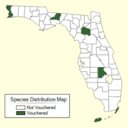 Fig. 55  Fig. 55. A. officinalis distribution map, wild populations Further Reading Michigan Asparagus, Michigan Asparagus Advisory Board ext link XIV International Asparagus Symposium, 2018, International Society for Horticultural Science ext link Asparagus-lover. Everything you ever wanted to know ext link An Introduction to Soil Salinity and Sodium Issues in New Mexico, New Mexico State University pdf Botanical Art Older Material Asparagus, 1931, 1996, A Modern Herbal Asparagus, 1919, 1972, Sturtevant's Edible Plants Of The World Asparagus, Sparagus, or Sperage, 1814, Culpeper's Complete Herbal List of Growers and Vendors | ||||||||||||||||||||||||||||||||||||||||||||||||||||||||||||||||||||||||
| Bibliography 1 Stephens, James, M. "Asparagus - Asparagus officinalis L." Horticultural Sciences Dept., UF/IFAS Extension, Pub. date April 1994, Revised Aug. 2015, Reviewed Oct. 2018, AskIFAS, edis.ifas.ufl.edu/mv013. Accessed 21 Dec. 2019. 2 Myers, Norm. "Asparagus in the home garden." Growing Asparagus, Michigan Asparagus, www.michiganasparagus.org/growing-asparagus. Accessed 11 Jan. 2020. 3 "Taxon: Asparagus officinalis L." USDA, Agricultural Research Service, National Plant Germplasm System, Germplasm Resources Information Network (GRIN-Taxonomy), National Germplasm Resources Laboratory, Beltsville, Maryland, 2019, U.S. National Plant Germplasm System, npgsweb.ars-grin.gov/gridnglobal/taxonomydetail.aspx?id=300050. Accessed 14 Jan. 2020. 4 "Asparagus officinalis L. var. altilis." hortanswers, University of Illinois Extension, web.extension.illinois.edu/hortanswers/plantdetail.cfm?PlantID=286&PlantTypeID=9. Accessed 15 Jan. 2020. 5 Masabni, Joseph. "Asparagus." Easy Gardening, Texas A&M AgriLife Extension, agrilifeextension.tamu.edu/library/gardening/asparagus/. Accessed 15 Jan. 2020. 6 Sims, William L., and Ronald E. Voss. "Growing Asparagus in the Garden." Vegetable Research and Information Center, Cooperative Extension University of California Division of Agriculture and Natural Resources 7177, UC Davis, vric.ucdavis.edu/pdf/asparagus_growingasparagus.pdf. Accessed 17 Jan. 2020. 7 Walker, Stephanie. "Asparagus Production in New Mexico." Cooperative Extension Service, College of Agricultural, Consumer and Environmental Science, Guide H-227, NMSU, aces.nmsu.edu/pubs/_h/H227/welcome.html. Accessed 18 Jan. 2020. 8 Flynn, Robert, and April Ulery. "An Introduction to Soil Salinity and Sodium Issues in New Mexico." College of Agricultural, Consumer and Environmental Sciences, CR 656, NMSU, aces.nmsu.edu/pubs/_circulars/CR656/welcome.html. Accessed 18 Jan. 2020. 9 "Asparagus officinalis Linnaeus, Sp. Pl. 1: 313. 1753." Flora of North America, FNA vol. 26 pp.212, 213, 214, eFloras, efloras.org/florataxon.aspx?flora_id=1&taxon_id=200027573. Accessed 18 Jan. 2020. 10 "Asparagus officinalis L." KewScience, Plants of the World online, powo.science.kew.org/taxon/urn:lsid:ipni.org:names:531229-1. Accessed 18 Jan. 2019. 11 Cantaluppi, Carl J., et al. "Asparagus: A Small-Scale Agriculture Alternative." Small Farm Program, USDA Division of Agriculture and Natural Resources, Cooperative State Research Service, Feb. 1994, UC Davis, sfp.ucdavis.edu/pubs/brochures/Asparagus/. Accessed 18 Jan. 2020. 12 "Toxic Plants (by scientific name)." Safe and Poisonous Garden Plants, University of California, Division of Agriculture and Natural Resources, UCANR, ucanr.edu/sites/poisonous_safe_plants/Toxic_Plants_by_Scientific_Name_685/#. Accessed 19 Jan. 2020. 13 Handbook of Medicinal Herbs. Second edition, James A. Duke, 2002. 14 Aegerter, Brenna et al. "Asparagus Production In California." Vegetable Production Series, UC Vegetable Research & Information Center, Pub. 7234, University of California, Agriculture and Natural Resources, 2011, UCANR, anrcatalog.ucanr.edu/pdf/7234.pdf. Accessed 19 Jan. 2020. 15 "Asparagus, raw." FoodData Central, U.S. Department of Agriculture, Agricultural Research Service, 1 Apr. 2019, USDA/ARS, fdc.nal.usda.gov/index.html. Accessed 29 Jan. 2019. Photographs Fig. 1 "UC 157 F1." Walker Brothers. Seeds and Plants, walkerseed.com/uc-157-f1/. Accessed 12 Jan 2020. Fig. 2 Bueltemann, Christian. "Asparagus time." 5 June 2017, pixabay, pixabay.com/photos/asparagus-vegetables-agriculture-2374183/. Accessed 27 Jan. 2020 Fig. 3 Muffet. "Asparagus bundled." 14 Apr. 2005, Wikimedia Commons, (CC BY 2.0), commons.wikimedia.org/wiki/File:Asparagus_image.jpg. Accessed 31 Jan. 2020. Fig. 4 Zell, H. "Asparagus officinalis, Asparagaceae, Asparagus, sprout; Stutensee, Germany. The fresh young subterranean sprouts are used in homeopathy as remedy: Asparagus officinalis (Aspar.)." 15 July 2009, Wikimedia Commons, (CC BY-SA 3.0), commons.wikimedia.org/wiki/File:Asparagus_officinalis_002.JPG. Accessed 21 Dec. 2019. Fig. 5 hochdahler. "Asparagus." 7 June 2018, pixabay, pixabay.com/photos/asparagus-green-asparagus-vegetables-3476898/. Accessed 31 Jan. 2020 Fig. 6 karitsu. "「やなば亭」のすぐ裏手にあるアスパラガスの畑。朝晩2回、ここで収穫されたアスパラがこの店で使われている。." 6 Aug. 2009, Wikimedia Commons, (CC BY-SA 2.0), commons.wikimedia.org/wiki/File: やなば亭-_アスパラ畑_(3836376178).jpg. Accessed 18 Jan. 2020. Fig. 7 Starr, Forest and Kim. "Asparagus officinalis (Asparagus) Habit at Wailuku, Maui, Hawai'i." Starr Environmental, 090721-3256, 21 July 2009, Wikimedia Commons, (CC BY 3.0 US), Image cropped, commons.wikimedia.org/wiki/File:Starr-090721-3257-Asparagus_officinalis-inflorescences-Wailuku-Maui_(24602854349).jpg. Accessed 21 Dec. 2019. Fig. 8 Starr, Forest and Kim. "Asparagus officinalis (Asparagus). Raised bed at Kawela, Molokai, Hawai'i." Starr Environmental, 090721-3256, 6 April 2012, Wikimedia Commons, (CC BY 3.0 US), commons.wikimedia.org/wiki/File:Starr-120406-4325-Asparagus_officinalis-raised_bed-Kawela-Molokai_(24771091189).jpg. Accessed 21 Dec. 2019. Fig. 9 Zell, H. "Asparagus officinalis, Asparagaceae, Asparagus, habitus; Stutensee, Germany. The fresh young subterranean sprouts are used in homeopathy as remedy: Asparagus officinalis (Aspar.)." 15 July 2009, Wikimedia Commons, (CC BY-SA 3.0), commons.wikimedia.org/wiki/File:Asparagus_officinalis_001.JPG. Accessed 21 Dec. 2019. Fig. 10 Szater. "Asparagus officinalis with dewdrops." 17 Sept. 2008, Wikimedia Commons, (CC BY-SA 3.0), commons.wikimedia.org/wiki/File:Asparagus_officinalis_dewdrop.JPG. Accessed 21 Dec. 2019. Fig. 11 aabacks. "Wild Asparagus (Asparagus officinalis)." iNaturalist, 53693198, 28 Sept. 2019, (CC BY-NC 4.0), Image rotated, www.inaturalist.org/photos/53693198. Accessed 30 Jan. 2020. Fig. 12,26,50,54 Jackson, K. A. "Asparagus Series." 2019, 2020, www.growables.org. Fig. 13 allycoconis. "Wild Asparagus (Asparagus officinalis)." Jordan River State Parkway, Salt Lake City, UT, US, iNaturalist, 24 June 2017, (CC BY-NC 4.0), www.inaturalist.org/observations/6777602. Accessed 30 Jan. 2020. Fig. 14 Webb, Matt. "Wild Asparagus (Asparagus officinalis)." Fort Collins, CO 80525, US, iNaturalist, 7 Oct 2019, (CC BY-NC 4.0), www.inaturalist.org/observations/33997690. Accessed 30 Jan. 2020. Fig. 15 Peters, Kristian. "Spargel Asparagus officinalis, Stoltera Nähe Rostock." 18 Sept. 2006, Wikimedia Commons, (CC BY-SA 3.0), commons.wikimedia.org/wiki/File:Asparagus_officinalis_bluete.jpeg. Accessed 21 Dec. 2019. Fig. 16 Rasbak. "(nl: Asperge in bloei) Asparagus officinalis flowering." 14 July 2005, Wikimedia Commons, (CC BY-SA 3.0), commons.wikimedia.org/wiki/File:Asperge_in_bloei_Asparagus_officinalis.jpg. Accessed 21 Dec. 2019. Fig. 17 Аимаина хикари. "Asparagus officinalis in Muromets island, Vyshhorod raion, Kiev oblast, Ukraine." 2 May 2015, Wikimedia Commons, Public domain, commons.wikimedia.org/wiki/File:Asparagus_officinalis_Muromets2.JPG. Accessed 21 Dec. 2019. Fig. 18,19 crazybirdy. "Wild Asparagus, (Asparagus officinalis)." Courtice, ON L1E 2T6, Canada, iNaturalist, 30 Sept. 2019, (CC BY-NC 4.0), Image cropped, www.inaturalist.org/observations/33646854. Accessed 30 Jan. 2020. Fig. 20 Stefan.lefnaer. "Asparagus officinalis." 15 June 2014, Wikimedia Commons, (CC BY-SA 3.0), commons.wikimedia.org/wiki/File:Asparagus_officinalis_sl1.jpg. Accessed 21 Dec. 2019. Fig. 21 Popov, Aleksandr. "Wild Asparagus, (Asparagus officinalis)." iNaturalist, 60025097, 1 Aug. 2013, (CC BY-NC 4.0), www.inaturalist.org/photos/60025097. Accessed 30 Jan. 2020. Fig. 22 bkinder832. "Wild Asparagus, (Asparagus officinalis)." Lake Ontario, Canada, 8 Sept. 2019, iNaturalist, (CC BY-NC 4.0), www.inaturalist.org/photos/52830669. Accessed 30 Jan. 2020. Fig. 23 Starr, Forest and Kim. "Seeds at Ulupalakua Ranch, Maui, Hawai'i." Starr Environmental, 120608-7382, 8 June 2012, Wikimedia Commons, (CC BY 3.0 US), commons.wikimedia.org/wiki/File:Starr-120608-7382-Asparagus_officinalis-seeds-Ulupalakua_Ranch-Maui_(25052136861).jpg. Accessed 21 Dec. 2019. Fig. 24 Stefan.lefnaer. "Garten-Spargel Asparagus officinalis, Fruit and seeds." 15 Nov. 2014, Wikimedia Commons, (CC BY-SA 4.0), commons.wikimedia.org/wiki/File:Asparagus_officinalis_sl7.jpg. Accessed 21 Dec. 2019. Fig. 25 Stefan.lefnaer. "Asparagus officinalis. Measured seeds of Asparagales." 15 Nov. 2014, Wikimedia Commons, (CC BY-SA 4.0), commons.wikimedia.org/wiki/File:Asparagus_officinalis_sl8.jpg. Accessed 21 Dec. 2019. Fig. 27 Starr, Forest and Kim. "Asparagus officinalis (Asparagus) Planted along driveway border at Kawela, Molokai, Hawai'i." Starr Environmental, no. 141025-2416, 25 Oct. 2014, Wikimedia Commons, (CC BY 3.0 US), commons.wikimedia.org/wiki/File:Starr-141025-2416-Asparagus_officinalis-planted_along_driveway_border-Kawela-Molokai_(25247679655).jpg. Accessed 21 Dec. 2019. Fig. 28 Dulal, Krish. "Roots of Asparagus officinalis found in Panchkhal Valley." 14 June 2013, Wikimedia Commons, (CC BY-SA 3.0), commons.wikimedia.org/wiki/File:Roots_of_Asparagus_officinalis.JPG . Accessed 21 Dec. 2019. Fig. 29 makamuki0. "Ladybug, Asparagus. Coccinella Septempunctata." 9 Mar. 2017, pixabay, pixabay.com/photos/ladybug-asparagus-detail-2133551/. Accessed 31 Jan. 2020 Fig. 30 Adams, Ryan. "Asparagus close-up." homedust.com, 27 June 2018, flickr, (CC BY 2.0), www.flickr.com/photos/. Accessed 27 Jan. 2020. Fig. 31 Dettwiler, Glenn. "Score.... Purple Asparagus!" 25 May 2015, flickr, (CC BY 2.0), www.flickr.com/photos/swisschef/. Accessed 27 Jan. 2020. Fig. 32 Ji-Elle "Pointes d'asperges blanches d'Alsace (Hoerdt)." 2 May 2015, Wikimedia Commons, (CC BY-SA 4.0), commons.wikimedia.org/wiki/File:Pointes_d'asperges_blanches_d'Alsace-Hoerdt.jpg. Accessed 31 Jan. 2020. Fig. 33 Dénes, Emoke "Garden asparagus or sparrow grass (Asparagus officinalis) in a market in Cambridge, England." 19 May 2019, Wikimedia Commons, (CC BY-SA 2.5), commons.wikimedia.org/wiki/File:Asparagales_-_Asparagus_officinalis_-_1.jpg. Accessed 31 Jan. 2020. Fig. 34 Zell, H. "Karlsruhe, Germany. The fresh young subterranean sprouts are used in homeopathy as remedy: Asparagus officinalis (Aspar.)." 2 June 2010, Wikimedia Commons, (CC BY-SA 3.0), commons.wikimedia.org/wiki/File:Asparagus_officinalis_005.JPG. Accessed 21 Dec. 2019. Fig. 35 "Harvesting white asparagus - the stalks in the foreground were freed of earth for the taking of the photograph." The Encyclopedia of Food, 1923, Wikimedia Commons, Public domain, commons.wikimedia.org/wiki/File:Harvesting_white_asparagus,_photo_from_The_Encyclopedia_of_Food_by_Artemas_Ward.jpg. Accessed 21 Dec. 2019. Fig. 36 Rosener, Ann. "Women in war. Summer canning workers. Food to make America strong. Women near Rochelle, Illinois, many of them schoolteachers and pupils, work in asparagus canning factories during the summer months." Sept. 1942, Wikimedia Commons, Public domain, Image cropped, commons.wikimedia.org/wiki/File:Food_to_make_America_strong._8b09752v.jpg. Accessed 21 Dec. 2019. Fig. 37 bernswaelz. "Asparagus field." pixabay, 18 Mar. 2016, pixabay.com/photos/agricultural-agriculture-cultivation-1265098/. Accessed 27 Jan. 2020. Fig. 38 Gellinger, Gerhard. "Asparagus field." pixabay, 28 May 2016, pixabay.com/photos/asparagus-vegetables-asparagus-time-1424527/. Accessed 27 Jan. 2020. Fig. 39 Bbb-Commons. "Fields of Asparagus (Food). Spargelacker." 30 April 2013, Wikimedia Commons, (CC BY-SA 3.0), commons.wikimedia.org/wiki/File:SchroHausen_SpargelAcker_2013-05.jpg. Accessed 21 Dec. 2019. Fig. 40 Johansson, Christer T. "Asparagus officinalis identifierad med hjälp av skylt i Västerås botaniska trädgård." 17 May 2014, Wikimedia Commons, (CC BY-SA 3.0), commons.wikimedia.org/wiki/File:Asparagus_officinalis-IMG_7258.JPG. Accessed 21 Dec. 2019. Fig. 41 "Asparagus tongs." Metropolitan Museum of Art, British, Sheffield; Asparagus tongs; Metalwork-Silverplate, 20 June 2017, Wikimedia Commons, Public domain, commons.wikimedia.org/wiki/File:Asparagus_tongs_MET_183254.jpg. Accessed 21 Dec. 2019. Fig. 42 Paquette, Darren. "Asparagus meat presentation food Image." 28 Feb. 2013, Wikimedia Commons, Public domain, commons.wikimedia.org/wiki/File:Asparagus_meat_presentation_food.jpg. Accessed 21 Dec. 2019. Fig. 43 domeckopol. "Asperges rôties avec des fraises et liées avec des asperges des bois." 25 May 2015, Wikimedia Commons, (CC0 1.0), commons.wikimedia.org/wiki/File:Roasted_asparagus_with_strawberries-836789.jpg. Accessed 21 Dec. 2019. Fig. 44 Talbot, H. Alexander. "White Asparagus, Smoked Salmon Roe, Maple Tapioca." 24 May 2006, Wikimedia Commons, (CC BY 2.0), commons.wikimedia.org/wiki/File:WhiteAsparagusSmokedRoeMapleTapioca_(8311588159).jpg. Accessed 31 Jan. 2020. Fig. 45 Wonderlane. "Asparagus ceramics dish and tea pot collection, Roma Al Fresco (Elisabeth Arden), Laslo for Mikasa, Cbk ltd 1991, Asparagus by Shafford 1986, green and light pink or purple, with miniature teapot, cups and plates, Seattle, Washington, USA." flickr, 7 Dec. 2008, (CC BY 2.0), www.flickr.com/photos/. Accessed 27 Jan. 2020. Fig. 46 Ziarnek, Krzysztof. "Asparagus officinalis seedling, plant cultivated in Szczecin, NW Poland." 27 Oct. 2018, Wikimedia Commons, (CC BY-SA 4.0), commons.wikimedia.org/wiki/File:Asparagus_officinalis_kz01.jpg. Accessed 21 Dec. 2019. Fig. 47 "Mary Washington Improved Asparagus." Gurney's Seed and Nursery, www.gurneys.com/product/mary_washington_improved_asparagus. Accessed 15 Jan. 2020. Fig. 48 W.carter. "Steam-boiling green asparagus (Asparagus officinalis) in a stainless steel pot in Lysekil, Sweden. By not submerging the whole asparagus, the tender tops of the shoots will only be steamed and retain their crispiness." 3 May 2018, Wikimedia Commons, Public domain, commons.wikimedia.org/wiki/File:Steam-boiling_green_asparagus.jpg. Accessed 21 Dec. 2019. Fig. 49 Talbot, H. Alexander. "Peeling white asparagus." 6 June 2008, Wikimedia Commons, (CC BY 2.0), commons.wikimedia.org/wiki/File:PeelingWhiteAsparagus_(8324642323).jpg. Accessed 21 Dec. 2019. Fig. 51 frank wouters. "Dish with asparagus in Belgium." 5 Jan. 2003, Wikimedia Commons, (CC BY 2.0), commons.wikimedia.org/wiki/File:Asperges_-_by_frank_wouters.jpg. Accessed 21 Dec. 2019. Fig. 52 bongo vongo. "Roasted Asparagus. The farmer from Evesham, who grew and sold me the asparagus, suggested a cooking method. Boil them for 12 minutes and then serve simply with butter. I consulted the Internet and decided to roast my bunch instead. Olive oil, salt, pepper and chopped garlic cooked in the oven at 200 degrees Centigrade for about 12 minutes. Delicious even if I say so myself." 27 Apr. 2011, Wikimedia Commons, (CC BY-SA 2.0), commons.wikimedia.org/wiki/File:Roasted_Asparagus_(5662545366).jpg. Accessed 21 Dec. 2019. Fig. 53 T.Tseng. "Hainanese Chicken Rice with asparagus at Flock and Fowl in Las Vegas, Nevada." Wikimedia Commons, 17 Mar. 2016, (CC BY 2.0), commons.wikimedia.org/wiki/File:Hainanese_Chicken_Rice,_with_asparagus.jpg. Accessed 21 Dec. 2019. Fig. 55 Wunderlin, R. P., et al. "Asparagus officinalis Distribution Map." Institute for Systematic Botany, University of South Florida, Tampa, S. M. Landry and K. N. Campbell (application development), USF Water Institute, 2019, Atlas of Florida Plants, florida.plantatlas.usf.edu/Plant.aspx?id=1774. Accessed 22 Dec. 2019. * UF/IFAS Assessment of Non-native Plants in Florida's Natural Areas ** The information provided above is not intended to be used as a guide for treatment of medical conditions using plants. Published 7 Feb. 2020 KJ. Last update 25 Jan. 2024 LR | |||||||||||||||||||||||||||||||||||||||||||||||||||||||||||||||||||||||||
